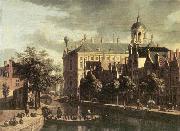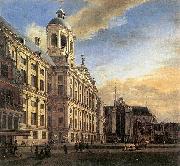Wholesale Oil Painting Reproductions No Minimum and Door to Door! |
|||||||||||
|
|
|||||||||||

|
|||||||||||
|
|
|
||||||||
All BERCKHEYDE, Gerrit Adriaensz. Oil Paintings |
||||||||
|
|
||||||||
|
|
||||||||
|
Artist Introduction: Dutch Baroque Era Painter, 1638-1698
Brother of Job Berckheyde. Gerrit specialized in a particular type of architectural subject, the TOWNSCAPE. His painted work shows a debt not only to Pieter Saenredam's conception of the building portrait but also to Saenredam's refined draughtsmanship and dispassionate attitude; these qualities mark Berckheyde as a classicist and akin to Vermeer. Berckheyde favoured views of monuments on large open squares, a choice that distinguishes him from the other great Dutch townscape painter, Jan van der Heyden, who preferred views along canals in which clarity was sacrificed for pictorial effect. |
||||||||
|
|
||||||||
|
Amsterdam Painting ID:: 63076 |
the Nieuwezijds near the Bloemmarkt 1670-75 Oil on canvas, 45 x 61 cm Historisch Museum, Amsterdam The first paintings of canals as independent subjects were made in Holland, after 1660, in the cities of Amsterdam and Haarlem, and Gerrit Berckheyde's painting is an impressive example of this development. Looking from the Weessluis towards the north, this view shows the Nieuwezijds, bordered by the Bloemmarkt on the left and the Pijpenmarkt on the right. Both quays are lined with trees; a rowboat is being unloaded and draught horses are dragging their load over the cobble-stones. The Town Hall towers above the row of houses. The clarity of Berckheyde's composition owes much to his deft use of chiaroscuro. The shaded fa?ades of the Pijpenmarkt form a dark screen behind which the Town Hall rises, bathed in light. The dark reflections of the houses in the canal suggest depth and extend the distance between the illuminated quays on the left and right. The shadow on the Town Hall's western side serves to increase its volume, while at the same time forming an obstacle between the most important illuminated areas, namely the Bloemmarkt and the southern flank of the Town Hall. The painting is a stunning demonstration of Berckhyde^s ability to elevate topography to a higher order, without compromising accuracy. The gigantic new Town Hall of Amsterdam roused the popular imagination to such an extent that it was soon dubbed 'the eighth wonder of the world'. Following the completion of the lantern in 1665, the market was flooded with paintings depicting the colossal building. There seems to have been no lack of demand for them; Amsterdam boasted a great many rich, potential buyers. One might even say that the construction of the new Town Hall stimulated the development of the painted cityscape as an independent genre. Berckheyde made a number of paintings of the Town Hall, including several from the Dam Square, as well as five variations showing it from the Nieuwezijds. Artist: BERCKHEYDE, Gerrit Adriaensz. Painting Title: Amsterdam, the Nieuwezijds near the Bloemmarkt , 1651-1700 Painting Style: Dutch , , landscape |
|||||||
Height Width |
INS/CM Quality |
|||||||
|
X |
| |||||||
|
|
||||||||
All Jan van der Heyden Oil Paintings |
||||||||
|
|
||||||||
|
|
||||||||
|
Artist Introduction: 1637-1712
Dutch
Jan Van Der Heyden Gallery
Van der Heyden grew up in Gorcum, but the family moved to Amsterdam around 1650. They lived on Dam Square. As a young guy he witnessed the fire in the old townhall which made a deep impression on him. He later would describe or draw 80 fires in almost any neighborhood of Amsterdam. When he married in 1661 the family was living on Herengracht, the most fashionable canal in Amsterdam. In 1668 Cosimo II de' Medici bought one of his paintings, a view of the townhall with a manipulated perspective. Van der Heyden often painted country estates, like Goudestein, owned by Joan Huydecoper II. He was not good in drawing figures and used for his paintings a metal plate for bricks, a sponge or moss for the leaves. Johannes Lingelbach, Adriaen van de Velde und Eglon van der Neer assisted him drawing the figures. Jan van der Heyden also introduced the lamp post and in 1672 impoved the design of the fire engine. He died in wealth as the superintendent of the lighting and director of the (voluntary) firemen's guild at Amsterdam.
Van der Heyden was a contemporary of the landscape painters Hobbema and Jacob van Ruisdael, with the advantage, which they lacked, of a certain professional versatility; for, whilst they painted admirable pictures and starved, he varied the practice of art with the study of mechanics. Until 1672 he painted in partnership with Adriaen van de Velde. After Adrian's death, and probably because of the loss which that event entailed upon him, he accepted the offices to which allusion has just been made. At no period of artistic activity had the system of division of labour been more fully or more constantly applied to art than it was in Holland towards the close of the 17th century.
Van der Heyden, who was perfect as an architectural draughtsman insofar as he painted the outside of buildings and thoroughly mastered linear perspective, seldom turned his hand to the delineation of anything but brick houses and churches in streets and squares, or rows along canals, or "moated granges," common in his native country.
He was a travelled man, had seen The Hague, Ghent and Brussels, and had ascended the Rhine past Xanten to Cologne, where he copied over and over again the tower and crane of the great cathedral. But he cared nothing for hill or vale, or stream or wood. He could reproduce the rows of bricks in a square of Dutch houses sparkling in the sun, or stunted trees and lines of dwellings varied by steeples, all in light or thrown into passing shadow by moving cloud.
He had the art of painting microscopically without loss of breadth or keeping. But he could draw neither man nor beast, nor ships nor carts; and this was his disadvantage. His good genius under these circumstances was Adrian van der Velde, who enlivened his compositions with spirited figures; and the joint labour of both is a delicate, minute, transparent work, radiant with glow and atmosphere. |
||||||||
|
|
||||||||
|
|
Amsterdam Painting ID:: 87813 |
1667(1667)
Medium Oil on canvas
cyf |
||||||
Height Width |
INS/CM Quality |
|||||||
|
X |
| |||||||
|
|
||||||||
|
Prev Next
|
||||||||
|
|
||||||||
|
Related Paintings to Jan van der Heyden :. |
||||||||
|
|
||||||||
|
CONTACT US |


